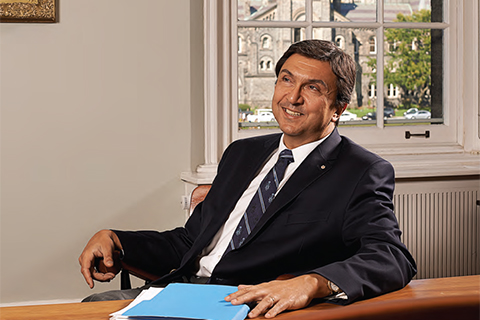Scarborough and Erindale colleges opened their doors in the mid-1960s as small extensions of the Faculty of Arts and Science. Over the decades, though, their transformation, like that of the Toronto region, has been truly remarkable. Even fairly recent graduates returning to the east and west campuses for Spring Reunion this year may be surprised to see how many impressive new buildings have sprung up and the variety of new programs being offered.
Today, with about 12,000 students each, and a mix of undergraduate and unique graduate programs, U of T Scarborough and U of T Mississauga have become mid-sized universities in their own right, and, within Ontario, are on track to rival Wilfrid Laurier and Queen’s in total enrolment. Although they operate somewhat independently, U of T’s three campuses together make up a single university, and therefore share important common ground: high academic standards; excellence in basic and applied research; unified graduate programs that ensure consistently strong scholarship; and a mission to provide undergraduates with an excellent academic experience that promotes personal initiative and open inquiry.
One can obtain a top-notch general arts education at UTM and UTSC, but the east and west campuses have also developed their own distinctive strengths in undergraduate programs that complement offerings at U of T St. George and offer unique resources to their local communities.
For example, many Canadian pharmaceutical and bio-tech companies have major operations in Mississauga. They work closely with UTM’s researchers to generate and test innovative new medicines and train industry professionals. Opportunities for collaboration will grow with the opening, last fall, of UTM’s new Terrence Donnelly Health Sciences Complex, which includes a new medical campus – one of just 18 in Canada.
Indeed, various knowledge-based industries in Mississauga draw on UTM’s unique professional graduate programs. These programs offer students deep, sector-specific training in such areas as bio-technology, finance and accounting, sustainability and innovation management. The goal is to educate industry experts who are capable of guiding innovation and economic development for a variety of emerging fields.
Like its counterpart in the western Toronto region, U of T Scarborough is enhancing its graduate program offerings and enrolment in areas where it already shows strength – particularly in environmental sciences, conservation and climate change, as well as clinical psychology and brain imaging.
UTSC’s long-standing involvement in co-operative education gives it another key advantage, differentiating it from its campus siblings – and from most other universities in Ontario. In today’s tough economic conditions, many employers are looking for university graduates who bring to the table a strong intellectual foundation and valuable career experience. UTSC has been a leader in co-operative university education for three decades, offering students strategic placements in some 40 programs spanning the arts, social sciences, business and international development. At the same time, U of T Scarborough has developed innovative undergraduate programs in the humanities and social sciences that attract some of the best students from the region.
Both UTM and UTSC are making internationalism a key strategic direction. Building on several strong international programs already on offer, UTSC has recently launched new programs in Global Asia Studies and African Studies, and is increasing its co-operative education initiatives with international placements. Students at both campuses, meanwhile, are teaming up with professors in their area of specialty to conduct research abroad. Both campuses are also becoming hubs for arts and culture, with programs that build on the rich multicultural dynamic of the surrounding communities. Partly because of their cultural context, UTSC and UTM are also becoming magnets for international students, who now have three ways to enjoy a Canadian university experience in a truly cosmopolitan region while earning a globally reputable U of T degree.
As UTSC and UTM mature into institutions that are at once local and global, they are becoming key drivers of higher education, research, innovation and prosperity in the east and west GTA. And as part of a truly regional University of Toronto system, with three wonderfully distinct campuses – they will continue to be distinguished by their academic rigour, excellent faculty and staff, bright students and commitment to providing an outstanding university experience.
Sincerely,
David Naylor
Recent Posts
U of T’s 197th Birthday Quiz
Test your knowledge of all things U of T in honour of the university’s 197th anniversary on March 15!
Are Cold Plunges Good for You?
Research suggests they are, in three ways
Work Has Changed. So Have the Qualities of Good Leadership
Rapid shifts in everything from technology to employee expectations are pressuring leaders to constantly adapt







One Response to “ Distinctive Strength ”
The president’s column commemorates the university’s relationship with bio-tech companies. Many groups around the globe, including Canadian farmers, are fighting against increasing control by bio-tech firms, notably in the food sector. So what exactly is the president’s message?
Mike Scapillato
UTSC 1972